2007 CHEVROLET MALIBU radio
[x] Cancel search: radioPage 152 of 510
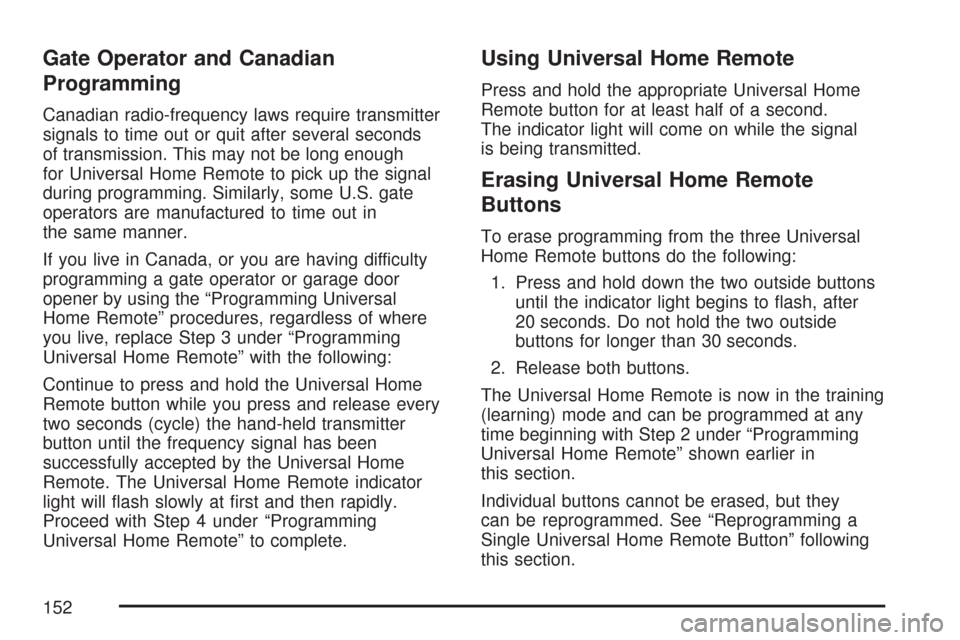
Gate Operator and Canadian
Programming
Canadian radio-frequency laws require transmitter
signals to time out or quit after several seconds
of transmission. This may not be long enough
for Universal Home Remote to pick up the signal
during programming. Similarly, some U.S. gate
operators are manufactured to time out in
the same manner.
If you live in Canada, or you are having difficulty
programming a gate operator or garage door
opener by using the “Programming Universal
Home Remote” procedures, regardless of where
you live, replace Step 3 under “Programming
Universal Home Remote” with the following:
Continue to press and hold the Universal Home
Remote button while you press and release every
two seconds (cycle) the hand-held transmitter
button until the frequency signal has been
successfully accepted by the Universal Home
Remote. The Universal Home Remote indicator
light will �ash slowly at �rst and then rapidly.
Proceed with Step 4 under “Programming
Universal Home Remote” to complete.
Using Universal Home Remote
Press and hold the appropriate Universal Home
Remote button for at least half of a second.
The indicator light will come on while the signal
is being transmitted.
Erasing Universal Home Remote
Buttons
To erase programming from the three Universal
Home Remote buttons do the following:
1. Press and hold down the two outside buttons
until the indicator light begins to �ash, after
20 seconds. Do not hold the two outside
buttons for longer than 30 seconds.
2. Release both buttons.
The Universal Home Remote is now in the training
(learning) mode and can be programmed at any
time beginning with Step 2 under “Programming
Universal Home Remote” shown earlier in
this section.
Individual buttons cannot be erased, but they
can be reprogrammed. See “Reprogramming a
Single Universal Home Remote Button” following
this section.
152
Page 166 of 510

Traction Control System (TCS)
Warning Light........................................ 209
Traction Control System Active Light......... 209
Enhanced Traction System Warning Light.... 210
Enhanced Traction System Active Light....... 210
Engine Coolant Temperature
Warning Light........................................ 211
Engine Coolant Temperature Gage............ 211
Malfunction Indicator Lamp........................ 212
Oil Pressure Light..................................... 215
Security Light............................................ 216
Cruise Control Light.................................. 216
Highbeam On Light................................... 216
Fuel Gage................................................. 217
Driver Information Center (DIC).................. 218
DIC Operation and Displays...................... 218
DIC Warnings and Messages.................... 222
DIC Vehicle Personalization....................... 225
Audio System(s)......................................... 228
Setting the Time for Radios without
Radio Data Systems (RDS).................... 229
Setting the Time for Radios with
Radio Data Systems (RDS).................... 230Radio with CD (Base Level)...................... 230
Radio with CD (Uplevel)............................ 236
Radio with Six-Disc CD............................. 246
XM Radio Messages................................. 259
Rear Seat Entertainment System............... 261
Rear Seat Audio (RSA)
(Without Entertainment System)............. 278
Rear Seat Audio (RSA)
(With Entertainment System).................. 280
Theft-Deterrent Feature............................. 281
Audio Steering Wheel Controls
(Three Spoke)........................................ 282
Audio Steering Wheel Controls
(Four Spoke).......................................... 283
Radio Reception........................................ 284
Care of Your CDs and DVDs.................... 285
Care of the CD and DVD Player............... 285
Fixed Mast Antenna (MAXX Only)............. 285
Backglass Antenna (Sedan Only).............. 286
XM™ Satellite Radio Antenna System....... 286
Section 3 Instrument Panel
166
Page 183 of 510
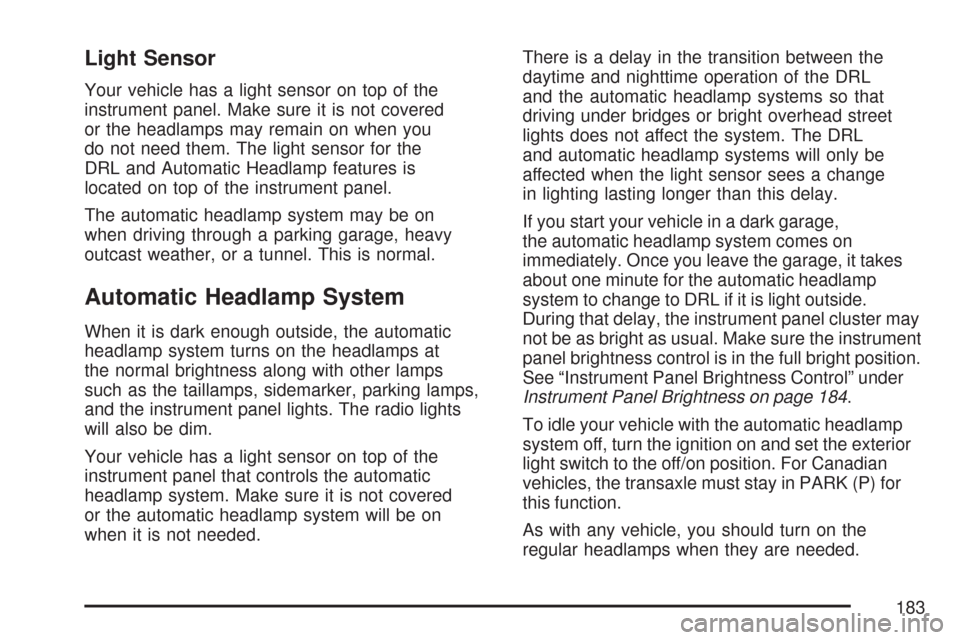
Light Sensor
Your vehicle has a light sensor on top of the
instrument panel. Make sure it is not covered
or the headlamps may remain on when you
do not need them. The light sensor for the
DRL and Automatic Headlamp features is
located on top of the instrument panel.
The automatic headlamp system may be on
when driving through a parking garage, heavy
outcast weather, or a tunnel. This is normal.
Automatic Headlamp System
When it is dark enough outside, the automatic
headlamp system turns on the headlamps at
the normal brightness along with other lamps
such as the taillamps, sidemarker, parking lamps,
and the instrument panel lights. The radio lights
will also be dim.
Your vehicle has a light sensor on top of the
instrument panel that controls the automatic
headlamp system. Make sure it is not covered
or the automatic headlamp system will be on
when it is not needed.There is a delay in the transition between the
daytime and nighttime operation of the DRL
and the automatic headlamp systems so that
driving under bridges or bright overhead street
lights does not affect the system. The DRL
and automatic headlamp systems will only be
affected when the light sensor sees a change
in lighting lasting longer than this delay.
If you start your vehicle in a dark garage,
the automatic headlamp system comes on
immediately. Once you leave the garage, it takes
about one minute for the automatic headlamp
system to change to DRL if it is light outside.
During that delay, the instrument panel cluster may
not be as bright as usual. Make sure the instrument
panel brightness control is in the full bright position.
See “Instrument Panel Brightness Control” under
Instrument Panel Brightness on page 184.
To idle your vehicle with the automatic headlamp
system off, turn the ignition on and set the exterior
light switch to the off/on position. For Canadian
vehicles, the transaxle must stay in PARK (P) for
this function.
As with any vehicle, you should turn on the
regular headlamps when they are needed.
183
Page 206 of 510
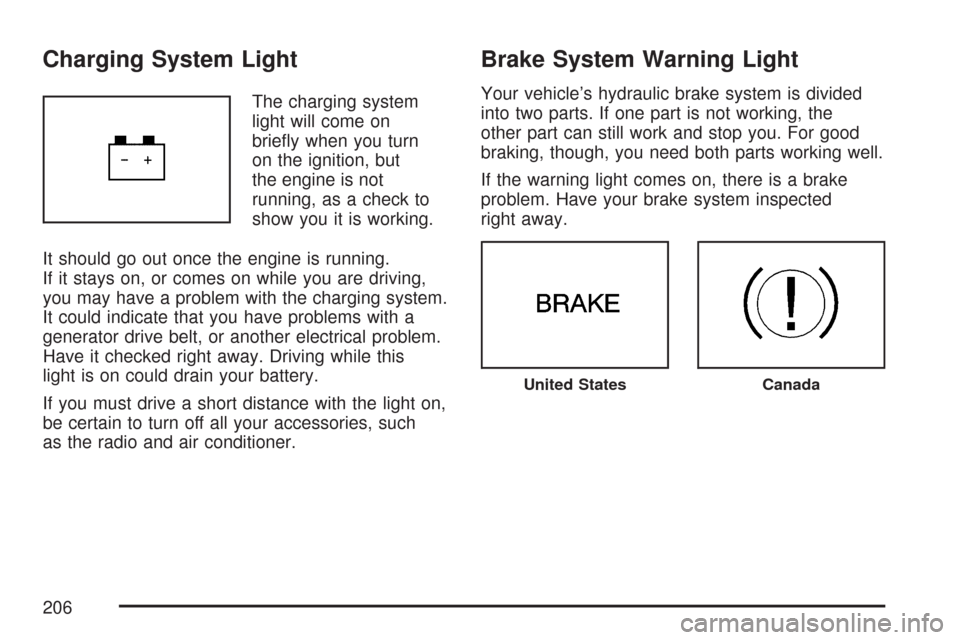
Charging System Light
The charging system
light will come on
brie�y when you turn
on the ignition, but
the engine is not
running, as a check to
show you it is working.
It should go out once the engine is running.
If it stays on, or comes on while you are driving,
you may have a problem with the charging system.
It could indicate that you have problems with a
generator drive belt, or another electrical problem.
Have it checked right away. Driving while this
light is on could drain your battery.
If you must drive a short distance with the light on,
be certain to turn off all your accessories, such
as the radio and air conditioner.
Brake System Warning Light
Your vehicle’s hydraulic brake system is divided
into two parts. If one part is not working, the
other part can still work and stop you. For good
braking, though, you need both parts working well.
If the warning light comes on, there is a brake
problem. Have your brake system inspected
right away.
United StatesCanada
206
Page 228 of 510
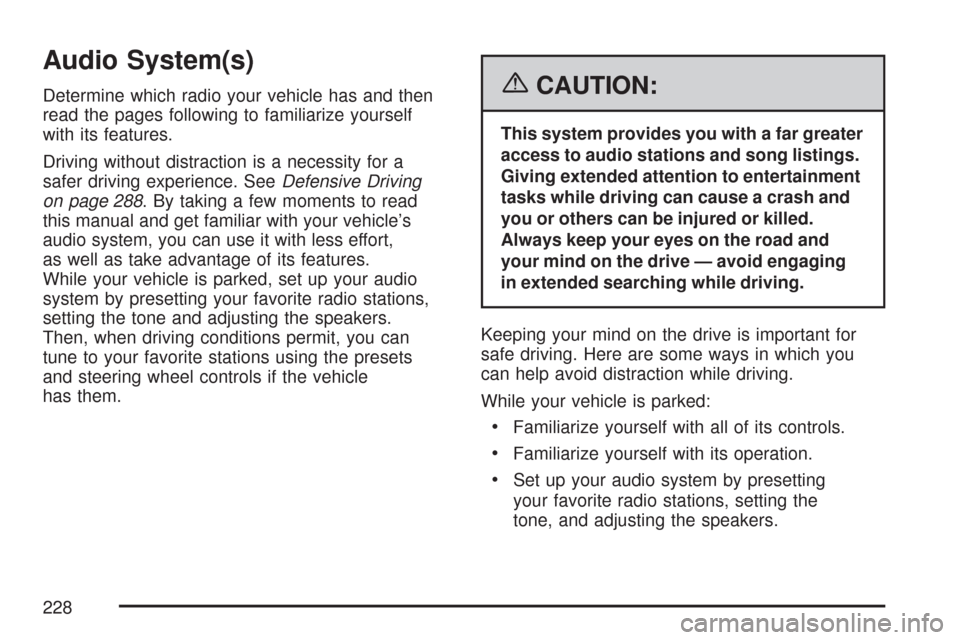
Audio System(s)
Determine which radio your vehicle has and then
read the pages following to familiarize yourself
with its features.
Driving without distraction is a necessity for a
safer driving experience. SeeDefensive Driving
on page 288. By taking a few moments to read
this manual and get familiar with your vehicle’s
audio system, you can use it with less effort,
as well as take advantage of its features.
While your vehicle is parked, set up your audio
system by presetting your favorite radio stations,
setting the tone and adjusting the speakers.
Then, when driving conditions permit, you can
tune to your favorite stations using the presets
and steering wheel controls if the vehicle
has them.{CAUTION:
This system provides you with a far greater
access to audio stations and song listings.
Giving extended attention to entertainment
tasks while driving can cause a crash and
you or others can be injured or killed.
Always keep your eyes on the road and
your mind on the drive — avoid engaging
in extended searching while driving.
Keeping your mind on the drive is important for
safe driving. Here are some ways in which you
can help avoid distraction while driving.
While your vehicle is parked:
Familiarize yourself with all of its controls.
Familiarize yourself with its operation.
Set up your audio system by presetting
your favorite radio stations, setting the
tone, and adjusting the speakers.
228
Page 229 of 510
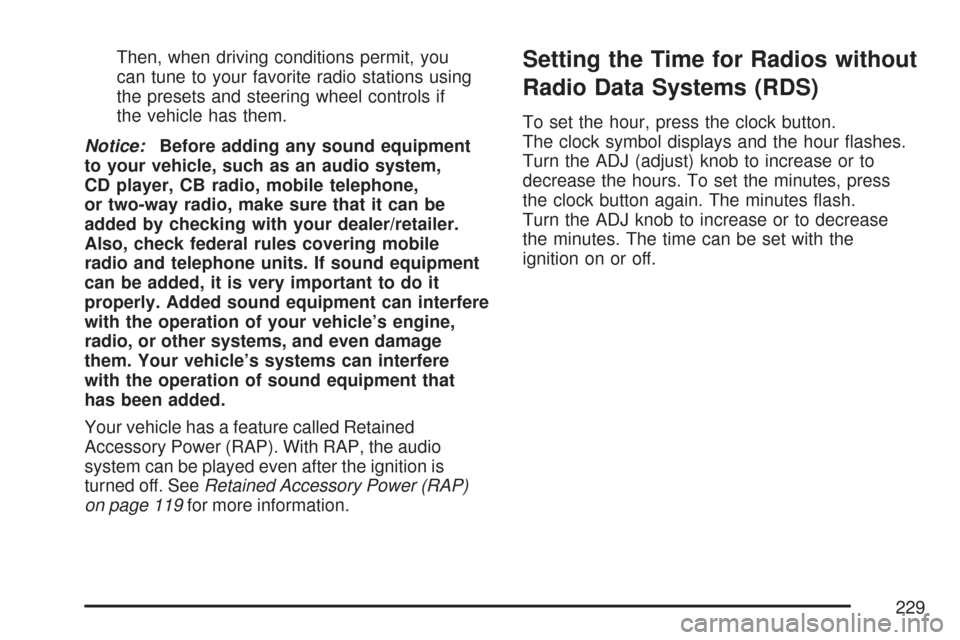
Then, when driving conditions permit, you
can tune to your favorite radio stations using
the presets and steering wheel controls if
the vehicle has them.
Notice:Before adding any sound equipment
to your vehicle, such as an audio system,
CD player, CB radio, mobile telephone,
or two-way radio, make sure that it can be
added by checking with your dealer/retailer.
Also, check federal rules covering mobile
radio and telephone units. If sound equipment
can be added, it is very important to do it
properly. Added sound equipment can interfere
with the operation of your vehicle’s engine,
radio, or other systems, and even damage
them. Your vehicle’s systems can interfere
with the operation of sound equipment that
has been added.
Your vehicle has a feature called Retained
Accessory Power (RAP). With RAP, the audio
system can be played even after the ignition is
turned off. SeeRetained Accessory Power (RAP)
on page 119for more information.Setting the Time for Radios without
Radio Data Systems (RDS)
To set the hour, press the clock button.
The clock symbol displays and the hour �ashes.
Turn the ADJ (adjust) knob to increase or to
decrease the hours. To set the minutes, press
the clock button again. The minutes �ash.
Turn the ADJ knob to increase or to decrease
the minutes. The time can be set with the
ignition on or off.
229
Page 230 of 510
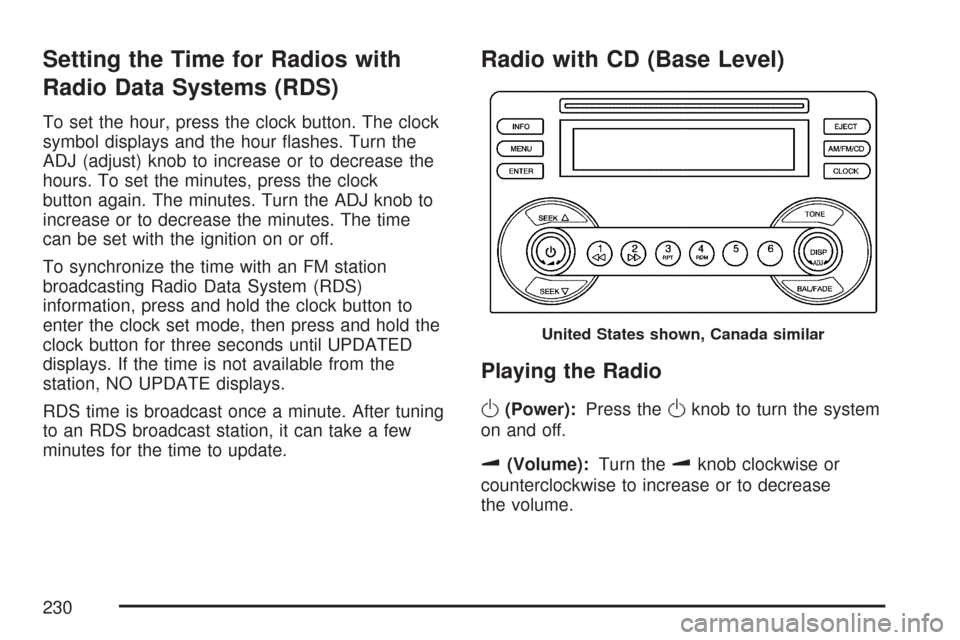
Setting the Time for Radios with
Radio Data Systems (RDS)
To set the hour, press the clock button. The clock
symbol displays and the hour �ashes. Turn the
ADJ (adjust) knob to increase or to decrease the
hours. To set the minutes, press the clock
button again. The minutes. Turn the ADJ knob to
increase or to decrease the minutes. The time
can be set with the ignition on or off.
To synchronize the time with an FM station
broadcasting Radio Data System (RDS)
information, press and hold the clock button to
enter the clock set mode, then press and hold the
clock button for three seconds until UPDATED
displays. If the time is not available from the
station, NO UPDATE displays.
RDS time is broadcast once a minute. After tuning
to an RDS broadcast station, it can take a few
minutes for the time to update.
Radio with CD (Base Level)
Playing the Radio
O
(Power):Press theOknob to turn the system
on and off.
u(Volume):Turn theuknob clockwise or
counterclockwise to increase or to decrease
the volume.
United States shown, Canada similar
230
Page 231 of 510
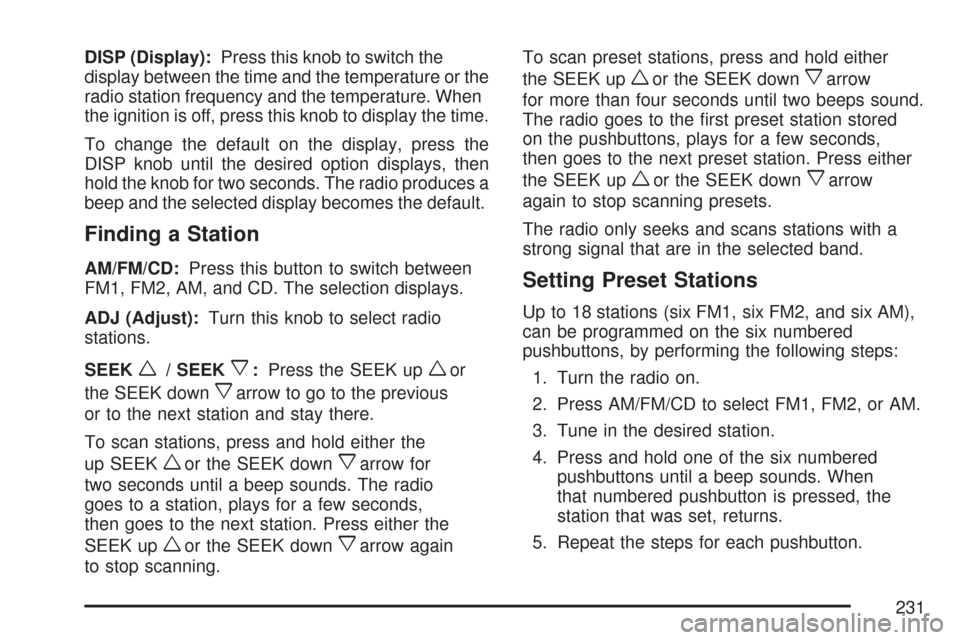
DISP (Display):Press this knob to switch the
display between the time and the temperature or the
radio station frequency and the temperature. When
the ignition is off, press this knob to display the time.
To change the default on the display, press the
DISP knob until the desired option displays, then
hold the knob for two seconds. The radio produces a
beep and the selected display becomes the default.
Finding a Station
AM/FM/CD:Press this button to switch between
FM1, FM2, AM, and CD. The selection displays.
ADJ (Adjust):Turn this knob to select radio
stations.
SEEK
w/ SEEKx:Press the SEEK upwor
the SEEK down
xarrow to go to the previous
or to the next station and stay there.
To scan stations, press and hold either the
up SEEK
wor the SEEK downxarrow for
two seconds until a beep sounds. The radio
goes to a station, plays for a few seconds,
then goes to the next station. Press either the
SEEK up
wor the SEEK downxarrow again
to stop scanning.To scan preset stations, press and hold either
the SEEK up
wor the SEEK downxarrow
for more than four seconds until two beeps sound.
The radio goes to the �rst preset station stored
on the pushbuttons, plays for a few seconds,
then goes to the next preset station. Press either
the SEEK up
wor the SEEK downxarrow
again to stop scanning presets.
The radio only seeks and scans stations with a
strong signal that are in the selected band.
Setting Preset Stations
Up to 18 stations (six FM1, six FM2, and six AM),
can be programmed on the six numbered
pushbuttons, by performing the following steps:
1. Turn the radio on.
2. Press AM/FM/CD to select FM1, FM2, or AM.
3. Tune in the desired station.
4. Press and hold one of the six numbered
pushbuttons until a beep sounds. When
that numbered pushbutton is pressed, the
station that was set, returns.
5. Repeat the steps for each pushbutton.
231